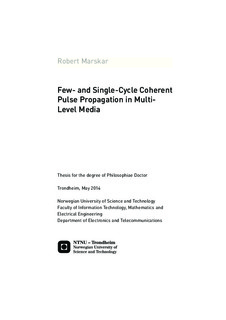| dc.contributor.author | Marskar, Robert | nb_NO |
| dc.date.accessioned | 2014-12-19T13:49:40Z | |
| dc.date.accessioned | 2015-12-22T11:50:17Z | |
| dc.date.available | 2014-12-19T13:49:40Z | |
| dc.date.available | 2015-12-22T11:50:17Z | |
| dc.date.created | 2014-07-24 | nb_NO |
| dc.date.issued | 2014 | nb_NO |
| dc.identifier | 735227 | nb_NO |
| dc.identifier.isbn | 978-82-326-0230-8 (printed ver.) | nb_NO |
| dc.identifier.isbn | 978-82-326-0231-5 (electronic ver.) | |
| dc.identifier.uri | http://hdl.handle.net/11250/2370999 | |
| dc.description.abstract | Recent experimental realizations of single-cycle pulses in the terahertz, infrared, and optical regions provide promising light sources for applications in telecommunication, medical imaging, spectroscopy, and coherent control. In the resonant regime, the short duration of such pulses imply that they may escape certain effects that are detrimental to coherence; spontaneous emission is one such example. In combination with an octave-spanning spectral bandwidth, an adequate theoretical approach necessitates a semiclassical coherence model outside the conventional few-level, rotating wave, and slowly varying envelope approximations. The evolution equations that govern the underlying dynamics of such systems are inherently nonlinear and possess solutions only in certain idealized, limiting cases. In this thesis we investigate the viability of obtaining general-purpose numerical solutions to such problems.
A computational approach based on Maxwell’s equations coupled with a multi-level quantum mechanical model for homogeneously and inhomogeneously broadened media is reported. The formulation leads to a numerical algorithm applicable to bi-directional propagation of pulses of arbitrary duration along all three spatial coordinates. For sufficiently dense inhomogeneously broadened materials we show, numerically, that when the forward propagation approximation of Maxwell’s wave equation is not valid, certain types of optical solitons may lose a significant amount of energy with increasing propagation distance through the co-excitation of a backward mode.
A second set of computational routines is based on neglection of optical backpropagation in Maxwell’s wave equation. The resulting propagation equation generalizes the paraxial wave equation to the single-cycle pulse regime and is shown to be susceptible to numerical integration in conjunction with quantum theory. Our computer code is applied to femtosecond conical emission in atomic sodium. We find that cone emission occurs together with spatiotemporal pulse breakup analogous to the soliton-type splitting observed in self-induced transparency. We furthermore support these results by presenting complementary numerical calculations of the same phenomenon in the picosecond pulse regime. The angular structure of the conical emission observed numerically agrees with expermental measurements performed by others. Our computational results resolve some of the underlying questions surrounding conical emission in alkali metal vapors.
Consideration of optical selection rules in rigid-rotor molecules is shown to greatly simplify the numerical evaluation of single-cycle pulse propagation in multi-level molecular systems. Numerical application of linearly polarized single-cycle terahertz pulses in rigid rotor molecular media, incorporating a full rotational manifold, shows that coherent bleaching effects ultimately lead to self-steepening of the driving pulse. A possible practical consequence of these results is that coherent, nonlinear saturation effects may partially cancel dispersion-induced temporal broadening of single-cycle pulses, opening up the possibility of increased energy transmission of terahertz pulses through molecular media. | nb_NO |
| dc.language | eng | nb_NO |
| dc.publisher | Norges teknisk-naturvitenskapelige universitet, Fakultet for informasjonsteknologi, matematikk og elektroteknikk, Institutt for elektronikk og telekommunikasjon | nb_NO |
| dc.relation.ispartofseries | Doktoravhandlinger ved NTNU, 1503-8181; 2014:154 | nb_NO |
| dc.title | Few- and Single-Cycle Coherent Pulse Propagation in Multi-Level Media | nb_NO |
| dc.type | Doctoral thesis | nb_NO |
| dc.contributor.department | Norges teknisk-naturvitenskapelige universitet, Fakultet for informasjonsteknologi, matematikk og elektroteknikk, Institutt for elektronikk og telekommunikasjon | nb_NO |
| dc.description.degree | PhD i elektronikk og telekommunikasjon | nb_NO |
| dc.description.degree | PhD in Electronics and Telecommunication | |
